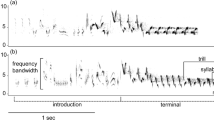Summary
Male red-winged blackbirds, like many other discontinuous singers, possess a repertoire of song types or renditions. We observed the behavior of four territorial males for over 500 h and recorded more than 7,600 songs to determine the functions of these repertoires. Analysis of the recordings and behavior revealed the following:
-
1.
Males in the present study have repertoires of 5–7 stereotyped song renditions. The frequency of delivery of each male's renditions differed during the first and second halves of the breeding season.
-
2.
There was no obvious tendency for the males to use specific renditions in certain social or environmental contexts.
-
3.
Of all rendition changes, 80% were immediately preceded by perch changes. Of the rendition changes occurring when the males were stationary, approximately 70% were in the presence of females or in apparent countersinging bouts with neighboring males, suggesting that both intersexual and intrasexual selection have influenced the elaboration of repertoires.
-
4.
Males did not avoid low recurrence intervals. This contrasts with other species with small repertoires which do tend to avoid low recurrence intervals.
Similar content being viewed by others
References
Armstrong, E.A.: A study of bird song. New York: Dover 1973
Catchpole, C.K.: The functions of advertising song in the sedge warbler (Acrocephalus schoenobaenus) and the reed warbler (A. scirpaceus). Behaviour 46, 300–320 (1973)
Falls, J.B., Krebs, J.R.: Sequence of songs in repertoires of western meadowlarks (Sturnella neglecta). Can. J. Zool. 53, 1165–1178 (1975)
Hartshorne, C.: The monotony-threshold in singing birds. Auk 83, 176–192 (1956)
Howard, R.D.: The influence of sexual selection and interspecific competition on mockingbird song. Evolution 28, 428–438 (1974)
Krebs, J.R.: Habituation and song repertoires in the great tit. Behav. Ecol. Sociobiol. 1, 215–227 (1976)
Krebs, J.R.: Song and territory in the great tit. In: Evolutionary ecology. Stonehouse, B., Perrins, C.M., (eds.) London: Macmillan 1977a
Krebs, J.R.: The significance of song repertoires: The Beau Geste hypothesis. Anim. Behav. 25, 475–478 (1977b)
Krebs, J., Ashcroft, RI, Webber, M.: Song repertoires and territory defense in the great tit. Nature 271, 539–542 (1978)
Kroodsma, D.: Reproductive development in a female songbird: Differential stimulation by quality of male song. Science 192, 574–575 (1976a)
Kroodsma, D.: The effect of large song repertoires on neighbor recognition in male song sparrows. Condor 78, 97–99 (1976b)
Lemon, R.E.: The relation between organization and function of song in cardinals. Behaviour 32, 158–178 (1968)
Nero, R.W.: A behavior study of the red-winged blackbird: I. Mating and nesting activities; II. Territoriality. Wilson Bull. 68, 4–150 (1956)
Orians, G.H., Christman, G.M.: A comparative study of red-winged, tri-colored and yellow-headed blackbirds. Univ. of Cal. Publ. in Ecology. 84, (1968)
Peek, F.: An experimental study of the territorial function of vocal and visual display in the male red-winged blackbird (Ageliaus phoeniceus). Anim. Behav. 20, 112–118 (1972)
Schleidt, W.: Tonic communication: Continual effects of discrete signals in animal communication systems. J. Theor. Biol. 42, 359–383 (1973)
Smith, D.G.: The role of the epaulet's in the red-winged blackbird (Ageliaus phoeniceus) social systems. Behaviour 41, 251–268 (1972)
Smith, D.G., Norman, D.O.: Leader-follower' singing in red-winged blackbirds. Condor 81, 83–84 (1979)
Smith, W.J., Pawlukiewicz, J., Smith, S.T.: Kinds of activities correlated with singing patterns of the yellow-throated vireo. Anim. Behav. 26, 862–884 (1978)
Author information
Authors and Affiliations
Rights and permissions
About this article
Cite this article
Smith, D.G., Reid, F.A. Roles of the song repertoire in red-winged blackbirds. Behav Ecol Sociobiol 5, 279–290 (1979). https://doi.org/10.1007/BF00293676
Received:
Issue Date:
DOI: https://doi.org/10.1007/BF00293676




